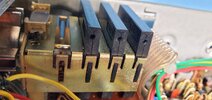Hi Everyone,
So, on the bench is a Tram D62 which is the same radio as the Cobra 132 and is shown in Sams 179. This radio performs well overall but is sparatic in transmitting on 36, 37, 38, 39 and will will almost never transmit on 40. This is true on AM, LSB and USB. When you key the mic in AM (mic gain at 0) you will see deflection on the bench meter but the transmit light on the radio does not come on. I have carefully drilled a small hole in the side of the 3 channel selector housings and sprayed Deoxit F5 (green can) and spun the channel selector a ton with no change in performance.
Any Thoughts?

So, on the bench is a Tram D62 which is the same radio as the Cobra 132 and is shown in Sams 179. This radio performs well overall but is sparatic in transmitting on 36, 37, 38, 39 and will will almost never transmit on 40. This is true on AM, LSB and USB. When you key the mic in AM (mic gain at 0) you will see deflection on the bench meter but the transmit light on the radio does not come on. I have carefully drilled a small hole in the side of the 3 channel selector housings and sprayed Deoxit F5 (green can) and spun the channel selector a ton with no change in performance.
Any Thoughts?

